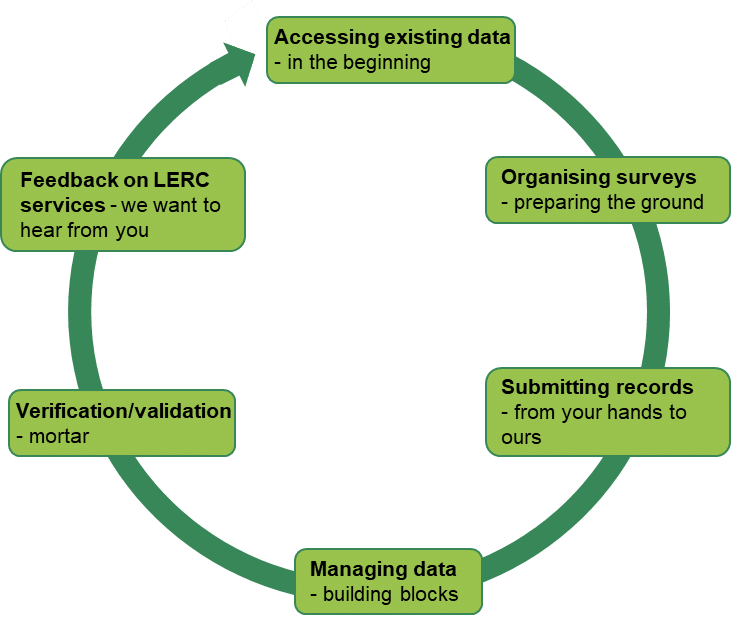
” … data itself was soulful and glowing, a dynamic aspect of the life process.” – Don DeLillo, Cosmopolis
Data sharing is an integral part of GiGL’s work. It can also benefit you and your clients. We want to provide you with a better sense of how data fits within our work flow. Follow our “life cycle” of GiGL data for further insight.
Accessing Existing Data
– in the beginning
Whether your services have been enlisted very early on in the pre-planning stages by a developer, at some later point in the physical development of a site when something unforeseen appears or at any time in between, you will likely do a desk study in preparation for carrying out the required works.
Local environmental record centres (LERCs) have been acting as centralised repositories for environmental data for some time now. Data holdings are being updated continuously and their quality checked rigorously.
You can access the relevant biodiversity data in support of your desk study by requesting a data search report tailored to the site in question.
Organising Surveys
– preparing the ground
You’ve decided, based on your desk study, to go ahead with surveying the site in question. GiGL provide expert advice and support on data standards for organisations undertaking surveys. As part of this service, GiGL have produced a suite of guidance documents tailored to specific survey types, outlining recommended data standards and resources available.
To make it simple for you to share your data with us, you can record your survey data using our recorder spreadsheet here.
Sharing your data with GiGL contributes to data flow in London and nationally and will help contribute to important decison making processes.
Submitting Records
– from your hands to ours
LERCs are very aware that consultants collect high priority species and habitats data – especially useful to statutory nature conservation bodies, such as Natural England and the Environment Agency. What’s more, we know that these data are at a high resolution linking species records to sites and habitats. This has particular value informing the planning process.
Providing your data to us helps to build a better evidence-base and make the ecological appraisal part of the planning process more effective. In turn, by accessing data when you need it, allows you to do a more thorough job for your client.
Submitting your records to us couldn’t be easier and we are still happy to receive them even if the recorder spreadsheet wasn’t used. Records can be sent to us directly, or get in touch to find out how we can assist. Our contact details are here.
Inputting/Managing Data
– building blocks
Sound data management underpins what LERCs do for a living as much as any other function. Whatever its original source, a good record requires four essential elements – the recorder’s name, species name, location, and date of the recording…who, what, where, when.
LERCs add value to data. Collating it allows us to identify important sites and build a picture over time. We annotate the data with European, national and local protected and notable information (European protected species to local Biodiversity Action Plan species, rare plant registers for an area, as examples). We believe this assists you in understanding what is locally important and if there is a change in wildlife legislation or local importance. In turn, this helps you fulfill your client’s ecological data needs.
Read more about how we manage the data entry function of GiGL.
Validation and Verification
– the mortar
LERCS take the accuracy of their data holdings very seriously. Recorder advisory groups, set up to help with this important task, work closely with LERCs to ensure what we provide to you is the best data possible for your needs.
If you would like to learn more, please read this article from our 2008 newsletter.
